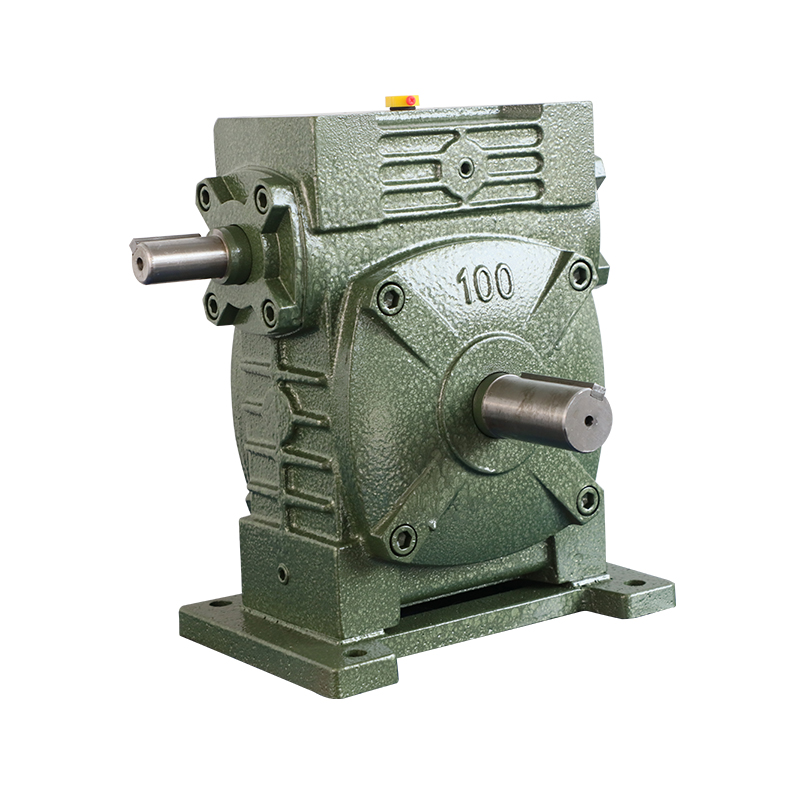Selecting the right WP Worm Gear Reducer is an important step to ensure equipment performance, improve efficiency and extend service life. Selecting the right WP Worm Gear Reducer based on the load and performance requirements of the equipment requires consideration of multiple factors, including load type, reduction ratio, power, speed, environmental conditions and usage requirements.
Determine the load requirements of the equipment
Load type: First, it is necessary to clarify the load characteristics of the equipment, whether it is constant load, variable load or impact load. WP Worm Gear Reducers are suitable for applications with constant loads and medium and low impact loads. If the load of the equipment is a high impact load, special consideration needs to be given to the load capacity and durability of the reducer.
Load size: Determine the torque requirement of the reducer based on the maximum working load of the equipment. The torque of the reducer should at least match the maximum load of the equipment. It is best to choose a reducer that can withstand a torque slightly greater than the maximum load to ensure a safety margin.
Determine the required reduction ratio
Reduction ratio selection: WP Worm Gear Reducers usually provide a large reduction ratio, so they are ideal for applications that require a significant reduction in speed. Select the appropriate reduction ratio based on the input speed of the equipment and the desired output speed.
Choose a reasonable reduction ratio range: For WP worm gear reducers, the reduction ratio generally provided is between 5:1 and 100:1, or even higher. When choosing, it is necessary to balance the reduction ratio and efficiency to avoid inefficiency and overheating problems caused by too high a reduction ratio.
Consider the power requirements of the equipment
Power calculation: Select an appropriate WP worm gear reducer according to the actual power requirements of the equipment. The reducer will affect the power output of the equipment, so the input power (motor power) of the reducer must match the output power required by the equipment. The power selection of the reducer should be determined based on the calculated load torque and speed.


Choose the right worm material and hardness
Worm material selection: The worm of the WP worm gear reducer usually uses alloy steel, while the worm part often uses cast aluminum, copper alloy or bronze. The choice of these materials will directly affect the load capacity, wear resistance and service life of the reducer.
Worm hardness: The hardness of the worm is usually higher (such as HRC55-60) to improve wear resistance and reduce friction loss.
Worm gear material: In order to ensure good self-lubrication and wear resistance, worm gears often use copper-containing materials, such as copper alloys or cast aluminum. Choosing the right material can increase the durability of the reducer and reduce operating costs.
Consider the working environment of the equipment
Ambient temperature: The working environment temperature of the equipment is very important for the selection of WP reducers. WP worm gear reducers generally adapt to ambient temperatures of -10°C to 40°C. If the working environment temperature is higher, you may need to consider a reducer with additional heat dissipation function, or choose lubricants and seals that are more resistant to high temperatures.
Humidity and corrosiveness: If the equipment is in a humid and corrosive environment, a reducer with a higher protection level (such as IP65 or above) should be selected, and ensure that the housing material of the reducer has corrosion resistance, such as using a stainless steel housing or coating.
Protection requirements: When selecting a reducer, it is also necessary to select the corresponding protection level according to the requirements of the application site, especially in a humid and dusty environment.
Consider the operating frequency and continuous running time of the reducer
Working cycle: If the equipment is continuously running for a long time, the WP worm gear reducer needs to have high thermal stability and continuous load-bearing capacity. In this case, it is particularly important to choose a heat-resistant reducer with good heat dissipation.
Start-up and shutdown frequency: If the equipment's workload varies greatly during startup and shutdown, it is very important to choose a reducer that can withstand impact loads to ensure that the reducer will not be damaged prematurely under frequent startup and shutdown conditions.
Consider the efficiency and power loss of the WP reducer
Efficiency and energy consumption: Since the transmission efficiency of worm gear reducers is relatively low, especially in the case of high reduction ratios, it is necessary to weigh efficiency and cost when selecting. If the equipment has strict requirements on energy efficiency, you can consider choosing products with high-efficiency designs in worm gear reducers, or use low-friction materials to reduce energy losses.
Power loss management: In equipment that runs for a long time, reducing power losses is crucial to reducing energy consumption and extending the life of the reducer. When purchasing, you can improve the overall efficiency by optimizing the reducer's lubrication system and selecting low-friction gear and worm materials.
When choosing a suitable WP worm gear reducer, the most important thing is to consider the equipment's load, power, speed, working environment, efficiency requirements, etc. By clarifying the specific needs of the equipment and matching the appropriate reducer, the stability and efficiency of the equipment can be ensured while the working life of the equipment can be extended.

 English
English русский
русский bahasa Indonesia
bahasa Indonesia
